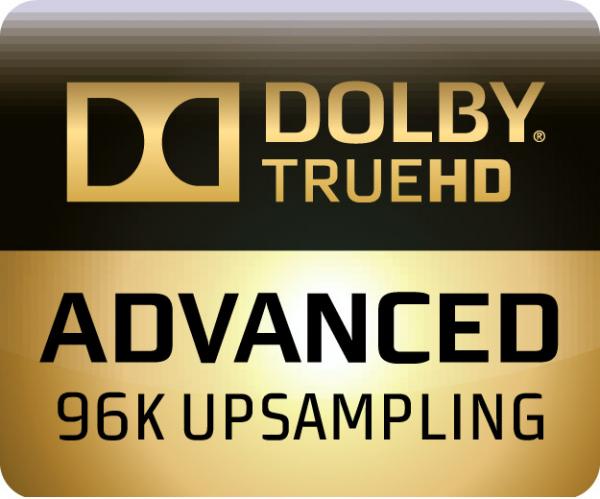New Format News: Dolby TrueHD with Advanced 96K Upsampling

Announced today, Dolby has added a new trick to their TrueHD encoding. It allows studios and authoring houses a way to upconvert standard 48 kHz content (the sampling rate of most movies) to 96 kHz for Blu-ray.
At an event at Dolby headquarters in San Francisco, I got a chance to hear the results. Interestingly, it was quite... interesting.
First, a brief primer. Digital sampling allows for the recording of frequencies up to half the rate of the sample. Or, in other words, to record a specific frequency, you need to sample at twice that rate. So a 48 kHz sample can record sounds up to 24 kHz. This is a common movie sampling rate, slightly higher than the common music (OK, CD) rate of 44.1 kHz. Now, as some of you probably know, the human ear is said to be able to hear from 20 Hz to 20 kHz. This is marginally true, in that a baby with perfect hearing can probably hear that range (but you try asking). Those of you capable of reading this sentence can hear in much narrower range, 20 Hz to 15 kHz if you’re lucky and didn’t hit up too many Bee Gees concerts in your youth.
Now a raw look at those numbers is likely causing most of you to ask: Um, what do I need musical information at 24 kHz, or 48 kHz for, when I can’t hear past 15 kHz? Good question. Here’s the thing: Digitally encoding high frequencies can cause artifacts lower in the frequency range which may be audible. These are mostly “ripples” caused by the brick wall anti-aliasing filter that prevents sounds above half the sampling frequency from being encoded.
One of the core features in the upconversion processing is similar to what Meridian uses in their high-end CD players. It’s called an “Apodizing Filter.” I’ll leave you to the white papers linked below for the technical details, but the short version is it moves “pre-ringing” artifacts to after a audio event. Here’s how Dolby describes it: “[The upconversion process] applies an advanced apodizing filter that masks preringing artifacts introduced upstream by analog-to-digital converters used in either the recording or playback stage by shifting them into postringing. The resulting increase in postringing is inaudible as it is masked. The apodizing filter does not remove any audio from the file. Instead, the filter shifts the location of unnatural artifacts that the brickwall filtering phenomenon of signal conversion introduces into content.”
Seems interesting, but going into the listening room, I was skeptical. However, I had an open mind. I’ve done bit rate and codec testing at Dolby before, and their listening test demos are done pretty much exactly as I’d do them. This time there wasn’t the double blind aspect I’d had with the bit rate tests, but the setup was similar. I also closed my eyes to see if I could pick the 48 from the 96 without looking (a TV in the room displayed the rate).
Despite warnings by Dolby that the effect was subtle, I found it readily apparent, as did my colleagues also present at the event. This is not the sort of change in sound like going from MP3 to CD, or even from CD to high-rez. The level of change is more like switching to a better DAC: subtle, but noticeable. The sound was more open, that was definite. Other effects, like better attack and decay, were very noticeable on a short Joe Satriani clip from an upcoming concert Blu-ray. The high-hat at the beginning of the track sounded more natural, less “recorded.”
Going back and forth between 48 kHz and 96 kHz with some movie clips, the 48 kHz version sounded a little more closed in. The 96 was easier to listen to at higher volumes. A clip from The Dark Knight, where Batman kidnaps the mob money guy, had high-pitched beeps (of the bombs) plus extensive glass shattering. The 48 kHz version had a touch more harshness. The 96 kHz was just cleaner.
I hate to use the comparison, but it’s almost like the 48 kHz sounded more “compressed” even though both selections were lossless TrueHD samples. Let me be clear, the 48 kHz file sounds fine, but the 96 kHz definitely sounds better.
Bottom Line
The beauty of this new tech is there’s no new equipment to buy on your end, it’s done entirely on the mastering side. The upconversion is done before you ever touch the disc. So your current system is likely fully capable of playing back “TrueHD with Advanced 96K Upsampling.”
Will you hear a difference? Well, unfortunately the kind of A/B comparison I was able to do isn’t really possible. The tracks on the discs you’ll buy are already upconverted. Even if they put standard 48 kHz Dolby TrueHD and 96K Upsampling content on the same disc (doubtful), you won’t know if you’re listening to the same mix, or if the tracks are at the same volume (this is also true with comparing codecs on the same disc). So consider it an added bonus: you’re not paying extra for the added (albeit upconverted) resolution, it’s just there to add to your enjoyment.
Look for the logo above on discs soon. The first titles, Satchurated: Live in Montreal, San Francisco Symphony at 100, and the Chinese film The Flowers of War are all coming out in the next few months.
In the mean time, check out these two whitepapers on the tech behind it all. Dolby TrueHD Encoder with Advanced 96k Upsampling and Elevating the Performance of Lossless Audio in the Home Theater: Dolby TrueHD with Advanced 96k Upsampling
- Log in or register to post comments




































































